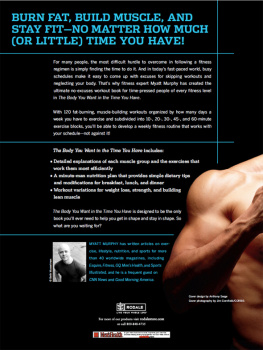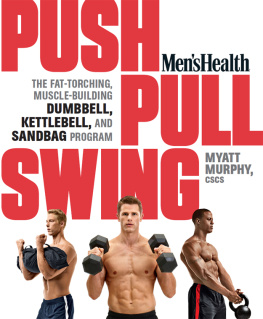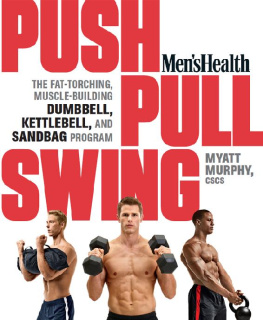
Notice
Mention of specific companies, organizations, or authorities in this book does not imply endorsement by the publisher, nor does mention of specific companies, organizations, or authorities imply that they endorse this book.
Internet addresses and telephone numbers given in this book were accurate at the time it went to press.
All rights reserved. No part of this publication may be reproduced or transmitted in any form or by any means, electronic or mechanical, including photocopying, recording, or any other information storage and retrieval system, without the written permission of the publisher.
2005 by Rodale Inc.
Cover photograph by Robert Wright
Interior photographs
Beth Bischoff p. 31, 32, 37, 38, 39, 42, 43, 48, 49, 50, 51, 64, 66, 67, 68, 69, 70, 71, 74, 76, 79, 84, 85, 86, 87, 88, 89, 90, 91, 92, 93, 94; Brand X
Pictures p. 6, 33; Corbis p. 14, 21; Digital Vision p. 63; Todd France p. 34, 35, 40, 41; Svend Lindbaek p. 89; Michael Mazzeo p. 11, 22, 23, 24, 25, 26, 27, 28, 29, 30, 44, 45, 46, 47, 52, 53, 54, 55, 58, 59, 60, 61, 62, 65, 72, 73, 75, 77, 78, 80, 81, 82, 83; Photodisc p. 9,16, 36.
Mens Health is a registered trademark of Rodale Inc.
Library of Congress Catalog-in-Publication data is on file with the publisher.
1594862591
eISBN-9781594862595

We insprie and enable people to improve their lives and the world around them
For more of our products visit rodalestore.com or call 800-848-4735
CONTENTS
INTRODUCTION

Most of your recreational activities dont involve weightsso knowing how to train without weights makes good sense.
When we picture a modern-day workout we almost always picture a guy at the gym standing, sitting, or lying down at a machine stacked with weights. Although theres no arguing that weight training can be an important part of any mans fitness routine, there are many practical reasons why a weight-free workout can be just as effective, serve as an occasional alternative to weights, or actually be more beneficial for certain types of men, depending on their fitness goals.
First of all, a weight-free workout can be done almost anywhere. The classic excuse, I dont have time to go to the gym, doesnt apply when youre working weight-free. Your gym can be your living room, your basement, or even your office. Research has shown that as little as 15 minutes a day in an effective, balanced workout can be immensely beneficial. So, who doesnt have 15 minutes each day to devote to working out weight-free wherever they might happen to be?
A weight-free workout can actually be necessary for some people who have suffered an injury. When your doctor has recommended a low-impact workout to limit stress on certain muscles or joints, or to help you recover from lower back pain, working out weight-free can be the right way to go because the resistance you use in a weight-free workout comes from your own muscles and body weight. You are not forcing yourself to deal with an unrealistic weight mass attached to a machine, dumbbell, or barbell.
A less obvious but increasingly understood element of working without weights has to do with the bodys core and sense of balance. Research into the muscles of the lower back and abdomen, and studies of fast-twitch muscle fibers and such core muscles as the psoas have consistently found that weight-free activities such as Pilates, yoga, and plyometrics help to enhance peoples ability to maintain proper balance, posture, and form, enabling them to move faster in quick bursts of energy when playing sports or working out. When you are standing, sitting, or lying at a weight machine, or trying to negotiate the weights attached to a dumbbell or barbell, you are working your muscles hard but not necessarily conditioning your lower back and ab-dominals to support your body most effectively.
STAY HEALTHY
Researchers examined the absentee records of 79,000 workers at 250 sites and found that those who maintained a minimum of two 20-minute workouts a week had fewer sick days than those who didnt exercise at all.
The basic stretches and exercises that make up a weight-free ). Weve also researched the latest in diet and nutrition information to maximize your progress. Research increasingly reveals that food, the essential fuel that powers your workout (and the rest of your day), is a vital component in any fitness program. Well give you the latest on carbohydrates (yes, there are good carbs), protein (perhaps the single most important solid food component for men working out and trying to lose weight), and how to satisfy your hunger while youre trimming fat and building muscle mass. Youll also get a rundown of the major muscles and how they relate to one another, because we believe that if youre going to make a disciplined weight-free workout routine a regular part of your life, you should understand exactly what parts of your body are being worked, why, and how you can prevent injuring yourself in the process.
A suggestion on how to read this book: Were not suggesting you dont know how to read, but we thought wed point out that if youre a few weeks away from hitting the beach for the first time this year, or if youre training for a marathon and are dying to know how a weight-free workout can strengthen your legs, dont feel compelled to take in the entire book at once. Flip around (for instance, to ) and find what interests you most.
Most of all, have fun. Weve had a blast putting these workouts and information together for you, and we hope youll enjoy yourself even more as you get to work on that new body of yours.
MEASURE UP
Youre embarking on a new fitness program; this book is your road map. But to use a map properly youve got to know where you are and where you want to go. The solution: Measure everything. Your neck, chest, waist, arms, thighs, and calves. Write it all down and put it someplace where youll have to look at it every day. Record your weight, too, although thats less important. Your goal: Maintain or reduce the size of your waist while increasing the size of everything else. Repeat your measurements every four weeks.
PART I:
The Weight-Free Way

Weight-Free Workout Basics
The history of weight-free workouts would probably begin many millennia ago when our forebears discovered the value of putting their muscles through their paces. Back then, such workouts were more commonly known as running for your life or defending your cave. Any way you look at it, weight-free has been around a lot longer than dumbbells, barbells, or any of the other finely calibrated machines in the modern-day gym. Today, weight-free means working your muscles by using your body weight, the force of gravity, and resistance created by props such as balls, blocks, and towels.










